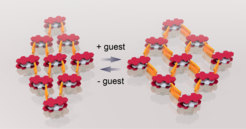Dynamics and physics of 2D frameworks
Dr. Florian Auras

Dynamic conjugated polymers and framework materials can switch between two or more phases of different geometries and porosities upon the uptake of guest molecules, temperature changes, or other suitable triggers. We develop semiconducting and dynamic framework materials and investigate how their switchable geometry can be employed to manipulate electronic and quantum states. This could offer new opportunities in a broad range of potential applications including highly selective sensors and organic spintronic materials for future information technologies.
Research Area I: Design and structural properties of dynamic 2D frameworks

While most 2D conjugated polymers and especially the long-range ordered 2D covalent organic frameworks (COFs) are rigid materials, we introduce a controlled degree of flexibility to allow them to change their geometry and porosity in response to external triggers. The key design challenges that we address in our work include maximising the dynamic geometry changes while fully retaining the integrity and long-range order of the frameworks, and expanding the range of possible triggers beyond the insertion of guest molecules.
Research Area II: Switchable optical, electronic and quantum properties

Electronic interactions between organic semiconductors are strongly influenced by their distance and relative orientation. Dynamic frameworks offer the unique opportunity to switch this intermolecular geometry and thus manipulate opto- and spin-electronic properties.
We investigate the influence of the framework geometry on the coupling between moieties that carry unpaired spins or electronic excitations. We are particularly interested in switchable organic magnetism and in long-lived high-spin excited states for exploring quantum phenomena


